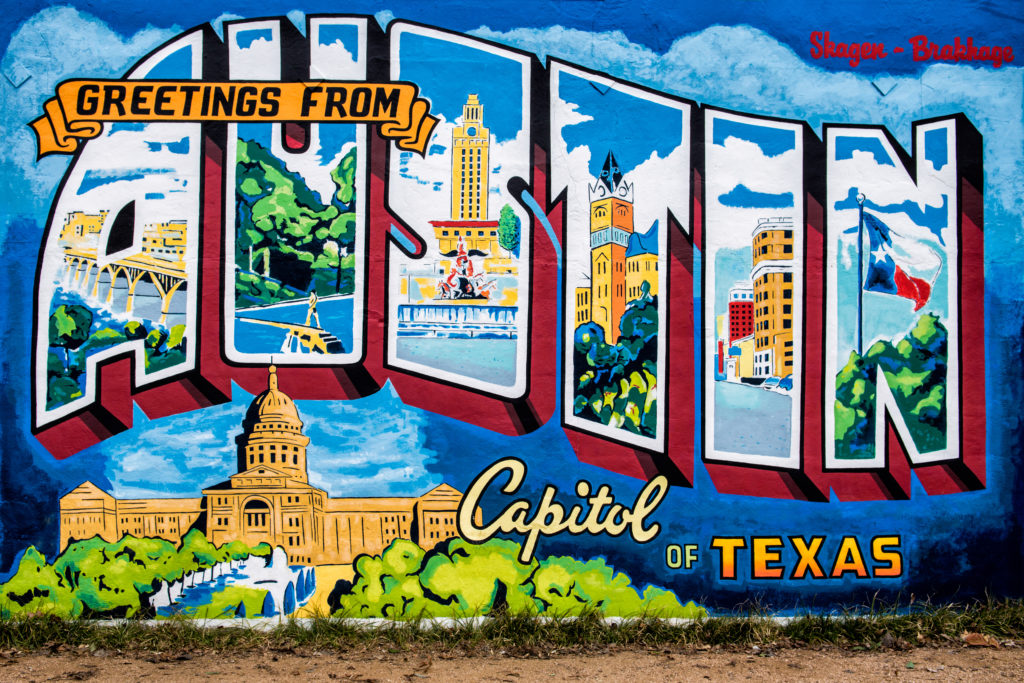
Last week, Seth Resler and I were in Austin to present to the Texas Association of Broadcasters. As usual, I spent most of my time at the hotel, presenting, schmoozing, and working. But Seth stayed behind with his girlfriend for a few days and experienced one of his cities. He saw a lot of changes, especially the way locals and tourists get around. It was like things we’ve seen at CES come to life. Enjoy. FJ
I love Austin. The boots, the bats, the breakfast tacos… So I was thrilled when the Texas Association of Broadcasters invited me to speak about digital strategy at their annual conference. I decided to stay a few extra days and make a long weekend out of it. My girlfriend had never been to the city, so she flew in and we explored the town together.
Austin has changed a lot since I first visited to attend SXSW almost two decades ago. As big tech has moved in and home prices have skyrocketed, the city’s skyline has grown. The Capitol dome is now dwarfed by a building shaped like a USB drive. The East Side, which has long been a haven for up and coming artists, has morphed into a strange mix of dive bars squeezed between luxury condos. And Torchy’s Tacos are the new Starbucks. In many ways, Austin showcases all the hallmarks of a mid-size city flourishing amidst a millennial renaissance, with bike lanes and food trucks and craft breweries.
So it’s no surprise that we found the future of transportation there as well.
For the last several years, the Jacobs Media team has been traveling to CES in Las Vegas to see what new technologies are coming our way. One of the big takeaways for me this year is that urban transportation is going to see a radical transformation.
In the past, if you lived in a city and you wanted to get from point A to point B, a car was often your only option. A handful of cities have good public transportation systems, and bikes or cabs might also be feasible in places, but for the majority of American city and suburb dwellers, a four-wheeled vehicle in the driveway has been a necessity.
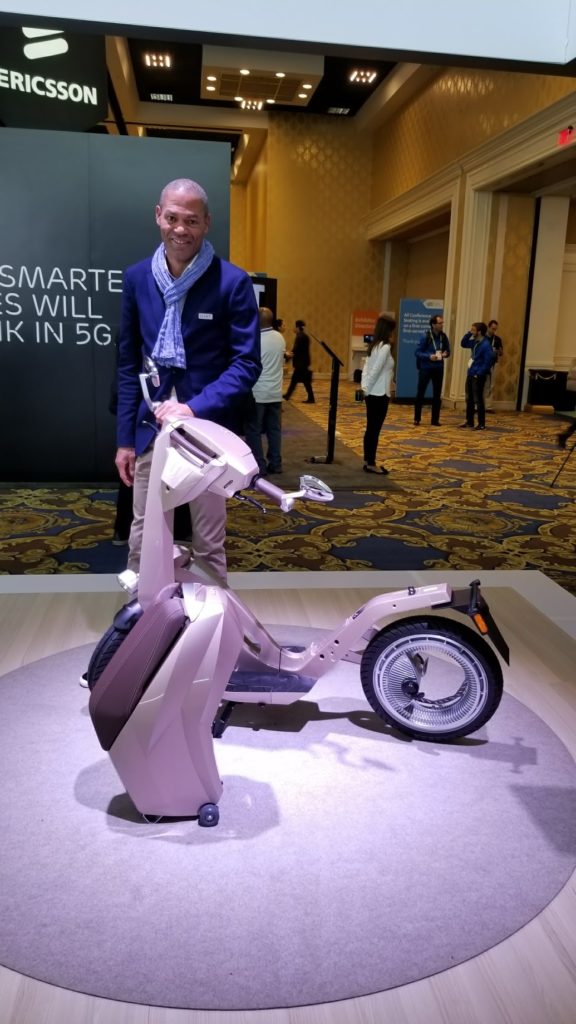
As we saw in Vegas, that’s about to change. Soon, if you want to go somewhere, you’re going to have a wide range of transportation options to choose from. We’ve already seen the proliferation of ride-sharing services like Uber and Lyft. Car sharing options like Turo and ZipCar are also gaining traction. At CES, I also saw everything from electric bikes to autonomous helicopters. But a few of the things on display in Vegas have already made their way to the streets of Austin.
Electric Scooters
For starters, Austin’s street corners are littered with Lime’s electric scooters. On our first day of vacation, we decided to take these scooters across the Ann W. Richards Congress Bridge to pick up some breakfast tacos at a food truck that we found on Yelp!. We downloaded the Lime app to our phones, entered our credit card info, and pointed the camera at the QR code on the handlebars. This unlocked the scooters, enabling their electric motors. The scooter warns you that the law requires you to wear a helmet while riding, but a quick scan of the neighborhood revealed the streets of Austin are apparently full of criminals — not a single scooter rider could be seen wearing a helmet.
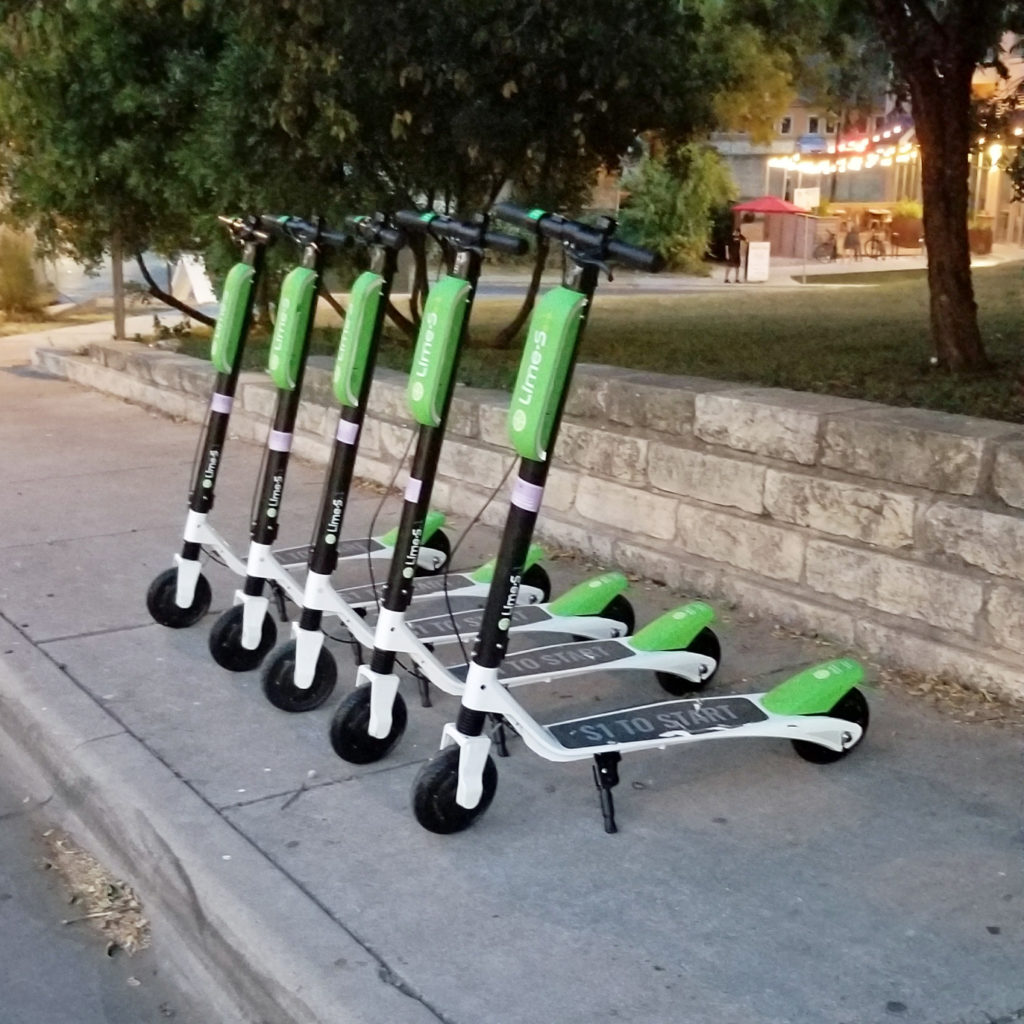
So we hopped on and crossed the bridge. My girlfriend mastered the skill of riding faster than I did. To be honest, I was nervous passing people on the sidewalk of the bridge on the scooter. I felt like I was one strong breeze away from toppling into oncoming traffic. Later that weekend, I asked one of our Lyft drivers how Austin was faring with the scooters. He told me that he had seen lots of accidents. The sidewalks weren’t built to accommodate riders and pedestrians, and at least once, he had seen an injured rider getting loaded into the back of an ambulance.
At the end of our ride, we dropped off the scooters on a street corner. These scooters are rugged, and unlike the shared bicycles, they don’t need to be parked at designated stations; you can drop them off anywhere you like, though the Lime app requires you to take a photo of the scooter to ensure that you’ve parked it safely out of the way.
The scooters were an enjoyable way to get around, though they seem to be better suited to a city like Austin where it doesn’t snow. Lime’s rival company, Bird, has recently launched an electric scooter pilot program in my home city of Detroit. I wonder how they’ll fare here given the weather.
It wasn’t hard to see that the scooters were getting a lot of use in downtown Austin, where the electric motors provide a nice alternative to trudging up the hills on foot. But it was also apparent this technology is rapidly becoming disruptive, and the city infrastructure (read: sidewalks and roads) weren’t designed to handle them. This could be an issue. Just as local lawmakers around the country have been forced to reckon with Uber, Lyft, and AirBnB, they may soon need to tackle electric scooters, and start solving these problems fast.
Bike Sharing
Our bike sharing experience was not as positive as the scooters. Austin has a number of different companies offering bikes throughout the city. We opted to go with B Cycle. Both the B Cycle and the Lime apps require a bit of initial setup, and neither one provided an ideal, intuitive user experience. B Cycle’s pricing plans were more complicated than Lime’s, and my girlfriend had so much trouble setting up her account that she was forced to call customer support.

The big difference between the scooters and the bikes is that the latter must be picked up and dropped off at designated stations where they are locked up. This forces you to plan your route in advance. The scooters have motors that are shut off by the Lime app, essentially rendering them unusable, and allowing you to leave them anywhere. The bikes don’t have motors, so they’re still usable, which is why they have to be locked up at a designated station.
Before selecting a bike, I felt the tires to make sure they had enough air. It turns out this cursory inspection wasn’t enough. One of the pedals on my bike was broken, while the brakes on my girlfriend’s bike squealed. The bikes were usable, but definitely not up to the standards we were used to on our own bikes. They are also built like tanks; they’re heavy so they can withstand the beatings they take from multiple users, but that doesn’t necessarily make for a smooth ride.
Of course, the bike allowed us to travel longer distances, but they were more work than the electric scooters when traveling uphill. We were thankful that we didn’t try to climb South Congress on these. I took my bike for a ride on the relatively flat bike path around Lady Bird Lake. It was an enjoyable ride, but my girlfriend and I agreed we preferred our scooter experience.
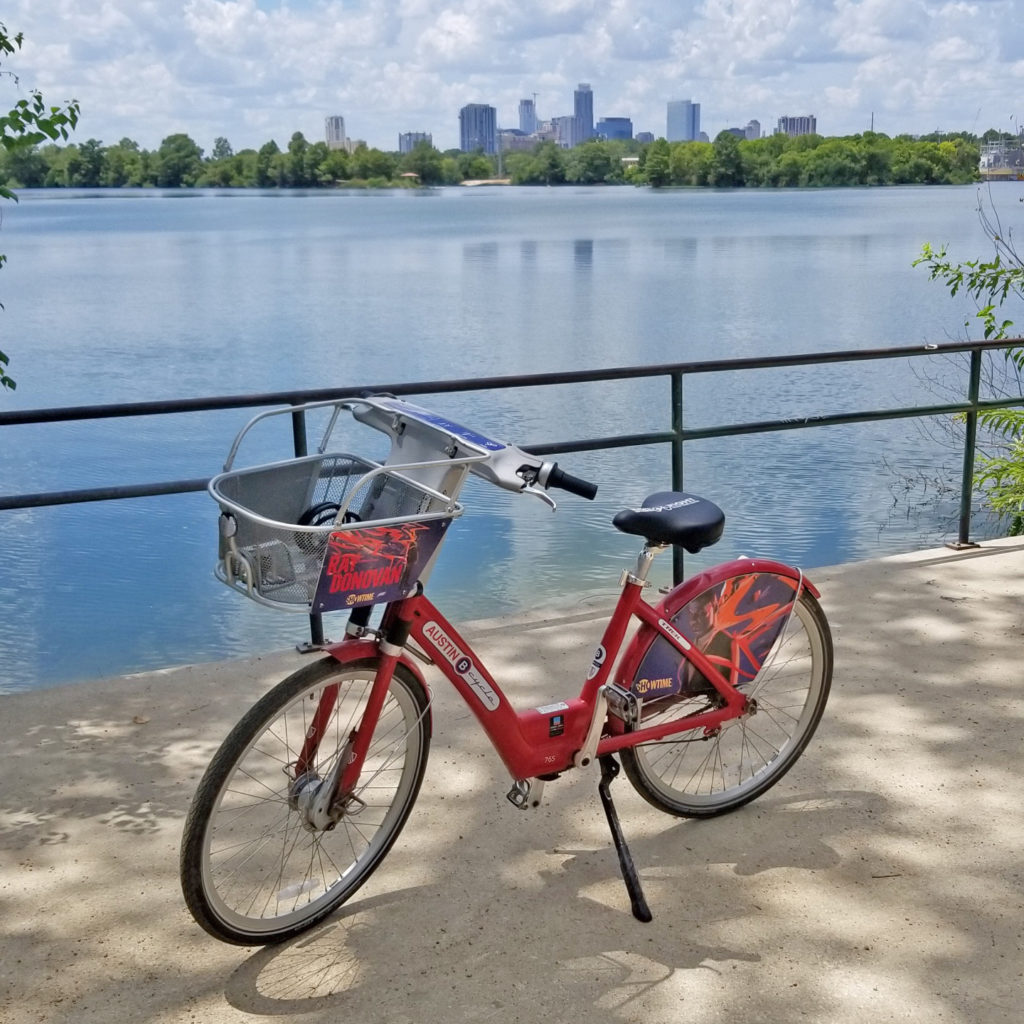
Feets, Streets, and Automobiles
Over the course of the weekend, we took advantage of other modes of transportation as well. We took half a dozen Lyft rides, none of which cost more than $8 before tip. Unlike Detroit, Austin has made accommodations for ride-sharing pickup at the airport, making it a feasible option whether you’re arriving or departing from the city.
One evening, we took an electric cab back from Rainey Street to our hotel. These cabs, which are little more than golf carts, are billed as “microtransit.” They’re an inexpensive, slow-speed, low-emissions way to take short trips around town after a Pecan Porter or two. You wouldn’t take one on the highway, but they’re perfect for navigating downtown traffic.
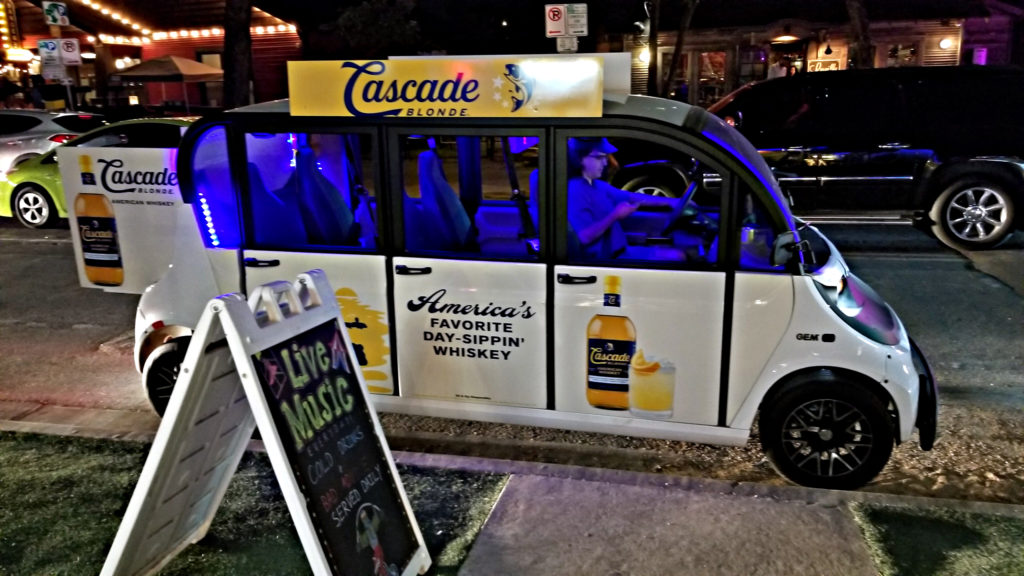
Of course, no trip to Austin would be complete without a ride in one of its rickshaws. This was a fun open-air trek from downtown to the new Ramen Tatsu-Ya location on the East Side, but it was pricey. One ride was worth the cost for the experience, but there are much more cost-effective ways to get around town.
We also walked a lot. After a couple of nights in our downtown hotel, we switched to a charming AirBnB just a few blocks from South Congress. August isn’t the best time to be wandering around outside, but it allowed us to get a more intimate look at the neighborhood.
At no point during the weekend did we set foot in a traditional, gas-powered cab. In fact, the only time the thought of a cab even crossed my mind was when we talked about visiting The Salt Lick, the legendary barbecue restaurant that’s a 30-minute drive from downtown. But Austin has enough worthy barbecue joints within city limits these days that we settled for something closer. (Of course, I did visit the airport location before skipping town!)
What This Means for Radio
Sure, we were 100% tourists during our weekend in Austin, and radio stations rely on the local population as audience members. But it was apparent many of the people taking advantage of these different forms of transportation were locals. For as long as most of us can remember, a radio has accompanied our modes of transportation. But there were no radios in these scooters, bikes, and rickshaws. Our Lyft drivers were always in control of the music in their cars, and we heard everything from country music to R&B by means of terrestrial radio, satellite radio, and streaming services.
Without radios, I suppose we could have listened to music through earbuds with our mobile phones, but to be honest, I would not have felt safe doing so on either the scooter or the bike. I did not see any others doing so either.
For the past several years at Jacobs Media, we’ve been talking about how important it is for radio stations to maintain their place in the dashboard as car manufacturers opt for computers that allow you to pair your smartphone, enabling ecosystems like Apple CarPlay and Android Auto. Now there’s a new wrinkle: it may not just be the traditional two knobs/6 presets radios disappearing; the dashboards themselves may be disappearing. As more and more people use shared scooters, bikes, and car services, radios will no longer be within easy reach. Broadcasters will need to continue to look for new ways to deliver their content to audiences – beyond the dashboard.

Autonomous cars aside, the future of transportation was on display in Austin – in 2018. And radio which has accompanied cars for most of the last century was missing in action over this weekend.
When it comes to who will listen to the radio and on which devices and modes of transportation, Austin offered up more questions than answers.
Add them to the list of questions that broadcast radio industry will need to tackle.
Soon.
- A Simple Digital Treat to Thank Your Radio Listeners This Thanksgiving - November 13, 2023
- Interview Questions When Hiring Your Radio Station’s Next Digital Marketing Manager - November 6, 2023
- A Radio Conversation with ChatGPT: Part 2 – Promotions - October 30, 2023




Leave a Reply